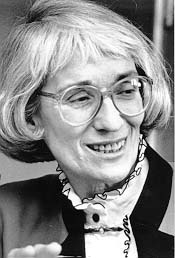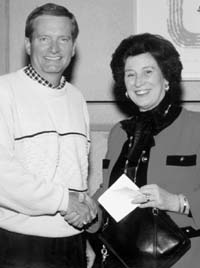SUNY Online Program Expands to 19 Campuses, 77 Courses, Graduate Level
By Rebecca Goldstein
Because of its success in the past year, the State University of New York’s computer online degree program will expand from eight to 19 campuses in the fall semester, including the University at Albany.
The SUNY Learning Network (SLN) program, which currently enrolls 282 students in 19 courses, will offer 77 courses to over 1,000 students in the fall. Courses will be on the undergraduate and graduate level and will include offerings in business, humanities and the sciences.
“Albany’s participation represents a first for SLN, which has thus far been implementing individual undergraduate courses through the community and four-year colleges,” said Carla Meskill of the Department of Educational Theory and Practice.
“This is a first both in that the Curriculum Design and Instructional Technology (CDIT) program is a graduate-level program and in that students will be able to complete the entire master’s degree on-line.”
The SUNY Learning Network will add the following campuses in the fall: Albany, Broome Community College, University at Buffalo, Environmental Science and Forestry in Syracuse, Herkimer County Community College, Mohawk Valley Community College, Monroe Community College, Oswego, Purchase, Tompkins-Cortland Community College and Westchester Community College. The Learning Network will continue to offer courses through Empire State College, New Paltz and Columbia Greene, Dutchess, Orange, Rockland, Sullivan, and Ulster Community Colleges.
“Because the program has been so well-received, we are almost quadrupling the number of online courses this fall,” said Interim Provost Peter D. Salins. “The SUNY Learning Network helps overcome the increasing challenges facing more and more adult and traditional college students.”
The SUNY Learning Network allows students to take individual courses or earn a degree right in their own homes, at their own time schedule, from multiple campuses around the state. This opportunity is provided over an Asynchronous Learning Network (ALN), the use of computers and the Internet as an educational vehicle that allows an on-going dialogue among students and faculty.
Funded in part by a grant from the Alfred P. Sloan Foundation, the SUNY Learning Network was praised in a newly released evaluation report done by Hezel Associates of Syracuse. The Hezel report said “the administrators of the project have proven the instructional viability of asynchronous learning by forming partnerships across campuses, offering market sensitive courses, and incrementally improving instructional quality.”
From an economic standpoint, the consultants concluded, the SUNY Learning Network increases enrollment from those unable to participate in on-campus classes, avoids cost duplications by sharing technology and marketing among several campuses, and makes New York State competitive with other states that offer distance learning. A market survey of prospective students shows that, with no advertising outside of New York, 20 percent of the prospective students for the program live out-of-state.
Faculty have been impressed with student performance to this point. “The level of class participation and discussion far exceeded, in quantity and quality, anything I have ever experienced in the traditional classroom setting,” said David Jaffee, a New Paltz professor.
Now, expectations as well as challenges are high as the program enters the graduate level. “There are, of course, critical differences in how course content and student involvement are conducted at the graduate level at a research institution,” said Albany’s Meskill. “As instructional technologists we will be pushing the medium and understanding about on-line instruction and paving the way for future graduate-level offerings in the SUNY system.”
While the location and method of transmission of SLN is unusual, the activities of a traditional class are the same—students read course materials, write papers, do research and communicate with their instructor and fellow students.
The project was budgeted last year at $1,204,000, with $548,000 coming from the Sloan Foundation’s Program in Learning Outside the Classroom, $387,000 of in-kind services from University campuses, and an infrastructure investment of $269,000 from SUNY’s Office of Educational Technology, which administers the program. Additional funds were used the previous year to get the project off the ground, beginning with four courses and 56 students in the fall of 1995.
C. Matt Samson, a graduate student in the Department of Anthropology, has
received a $14,500 grant from the Research Enablement Program (REP) to
support his study of the growth of Protestantism among Maya Indians in the
Western Highlands of Guatemala. Samson, a native of Clinton, La., is one of
16 award winners from among 121 applicants.
Samson will carry out a comparative ethnographic field study of two Maya
Protestant communities, with a focus on the significant growth of Indian
Protestantism in a nation that has an Indian majority. His work will also
examine the manner in which Maya maintain their ethnic identity even as
they have converted from so-called “traditional” Indian beliefs.
Anthropology faculty member Gary Gossen said Samson’s project will be an
important contribution to an understanding of perhaps the most
extraordinary feature of social change in late 20th Century Latin America.
“Protestantism currently surpasses both Liberation Theology and Marxist
guerrilla movements as a preferred ideological and lifestyle option for
tens of millions of Latin Americans,” Gossen said. “Guatemala has both a
majority Indian population and is also among those nations of the region
that have the largest percentage of Protestants — 20 to 30 percent. Mr.
Samson’s study promises to contribute to our understanding of these
significant forces in the ethnic and cultural configuration of contemporary
Latin America.”
Samson’s study is entitled Re-enchanting the World: Maya Identity and
Protestantism in the Western Highlands of Guatemala. The Research
Enablement Program is funded by the Pew Charitable Trusts of Philadelphia
and administered by the Overseas Ministries Study Center in New Haven,
Conn.
Sixteen scholars representing Germany, New Zealand, Nigeria, People’s
Republic of China, Russia, Tanzania, the United Kingdom and the U.S.
received the awards for research projects in the study of the world
Christian movement. The grants total approximately $293,000 and will be
dispensed for work in the 1997-1998 academic year. The REP is designed to
support projects dealing with the world Christian movement and its
interaction with the public sphere, especially in the non-Western world.
University at Albany Anthropology Student Wins $14,500 Grant
By Christine Hanson McKnight

 By Lisa James
By Lisa James
